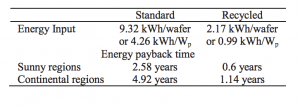Recyclability & Waste Management of Panels
- Due to relatively long life-spans of photovoltaic panels, ~30yrs, waste management policies have not been fully implemented on a national scale. [1]
- “Recycling the material in PV modules is already economically viable, mainly for concentrated and large-scale applications. Projections are that between 80 and 96% of the glass, ethylene vinyl acetate, and metals (Te, selenium and lead) will be recycled. Other metals, such as Cd, Te, tin, nickel, aluminium and Cu, should be saved or they can be recycled by other methods.” [3]
- The scarcity of certain metals require that feasible, cost effective approaches be pursued and consistently enhanced/updated [1]
- Life-cycle analyses suggests that batteries for stand-alone systems are responsible for most of the environmental impacts based on their “relatively short life-span, heavy metal content,” and the shear quantity of raw material and energy required for their production. This requires that greater attention be placed on waste management practices regarding batteries. [4]
Recycling Process
Modules with intact cells go through a process of thermal treatment where synthetic and organic material is burnt, leaving glass and metals to be resorted. Solar cells then go through an chemical etching if surfaces are damages.
![Figures displaying the stages of separation and recycling as well as the process of chemical etching [1]](http://sites.lafayette.edu/egrs352-sp15-pv/files/2015/05/Screen-Shot-2015-05-05-at-10.51.03-PM-300x96.png)
Figures displaying the stages of separation and recycling as well as the process of chemical etching [2]
Author: Kevin Jackson
Editor: Hannah Goldstein, Abby Studen
Sources
[1] California Energy Commission. (2004). Potential Health and Environmental Impacts Associated with the Manufacture and Use of Photovoltaic Cells. 3412 Hillview Avenue, Palo Alto, California
[2] Dubey, S., Jadhav, N.Y., Zakirova, B., (2012). Socio-Economic and Environmental Impacts of Silicon Based Photovoltaic (PV) Technologies. Energy Procedia 33 (2013), 322-334.
[3] Intergovernmental Panel on Climate Change. (2011). IPCC Special Report on Renewable Energy Sources and Climate Change Mitigation. Prepared by Working Group III of the Intergovernmental Panel on Climate Change [O. Edenhofer, R. Pichs-Madruga, Y. Sokona, K. Seyboth, P. Matschoss, S. Kadner, T. Zwickel, P. Eickemeier, G. Hansen, S. Schlömer, C. von Stechow (eds)]. Cambridge University Press, Cambridge, United Kingdom and New York, NY, USA, 1075 pp.
[4] Tsoutsos, T., Frantzeskaki, N., & Gekas, V., (2003). Environmental impacts from the solar energy technologies. Energy Policy. 33 (2005), 289-296.
